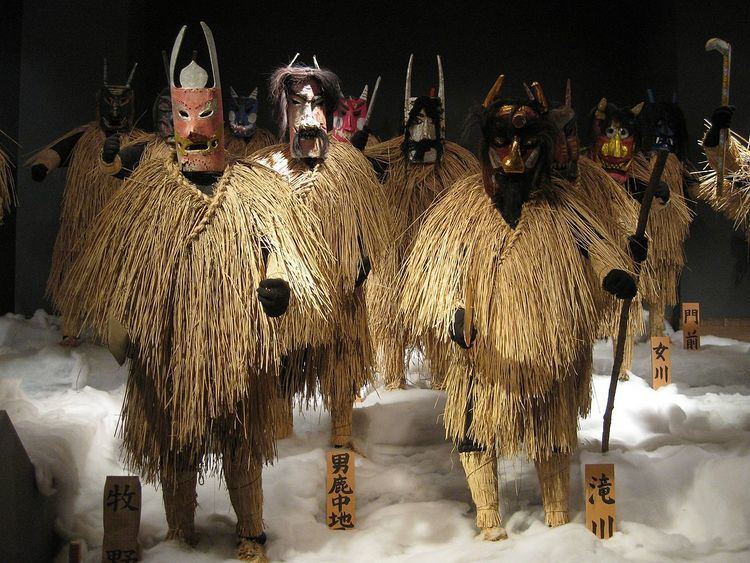 | ||
Namahage (生剥) in traditional Japanese folklore is a demonlike being, portrayed by men wearing hefty ogre masks and traditional straw capes (mino) during a New Year's ritual of the Oga Peninsula area of Akita Prefecture in northern Honshū, Japan.
Contents
- Older tradition
- Season
- Etymology
- Legend
- Interpretations
- Similar ogre traditions
- In popular culture
- References
The frightfully dressed men, armed with deba knives (albeit wooden fakes or made of papier-mâché) and toting a teoke (手桶?, "hand pail" made of wood), march in pairs or threes going door-to-door making rounds of people's homes, admonishing children who may be guilty of laziness or bad behavior, yelling phrases like "Are there any crybabies around?" (泣く子はいねがぁ, Nakuko wa inee gā?) or "Are naughty kids around?" (悪い子はいねえか, Waruiko wa inee ka?) in the pronunciation and accent of the local dialect.
Older tradition
The practice has shifted over the years.
Season
The namahage visits nowadays take place on New Year's Eve (using the Western calendar). But it used to be practiced on the so-called "Little New Year" (小正月, Koshōgatsu), the first full moon night of the year. This is the 15th day of the first lunar calendrical year, which is not the same thing as January 15; it usually falls around mid-February, exactly two weeks after the Chinese New Year (Japanese: Kyūshogatsu).
Etymology
The namahage's purpose was to admonish laggards who sit around the fire idly doing nothing useful. One of the refrains used by the namahage in the olden days was "Blisters peeled yet?" (なもみコ剝げたかよ, namomi ko hagetaka yo). Namomi signifies heat blisters, or more precisely hidako (火だこ, hidako) (Erythema ab igne or EAI), a rashlike condition caused by overexposure to fire, from sitting by the dugout irori hearth. Thus "Fire rash peeling" is generally believed to be the derivation of the name namahage.
Some of the namahage's other spoken lines of old were "Knife whetted yet?" (包丁コとげたかよ, hōchōko togetaka yo) and "Boiled adzuki beans done yet?" (小豆コ煮えたかよ, azuki ko nietaka yo). The knife apparently signified the instrument to peel the blisters, and it was customary to have azuki gruel on the "Little New Year".
Although the namahage are nowadays conceived of as a type of oni or ogre, it was originally a custom where youngsters impersonated the kami who made visitations during the New Year's season. Thus it is a kind of toshigami.
The namahage would typically receive mochi from the households they visited, but newlywed couples were supposed to play host to them in full formal attire and offer them sake and food.
Legend
The legend of the Namahage varies according to an area. An Akita legend has developed regarding the origins of namahage, that Emperor Wu of Han (d. 87 BC) from China came to Japan bringing five demonic ogres to the Oga area, and the ogres established quarters in the two local high peaks, Honzan (本山) and Shinzan (真山). These oni, as they are most commonly called in Japan, stole crops and young women from Oga's villages.
The citizens of Oga wagered the demons that if they could build a flight of stone steps, one thousand steps in all, from the village to the five shrine halls (variant: from the sea shore to the top of Mt. Shinzan) all in one night, then the villagers will supply them with a young woman every year. But if they failed the task they would have to leave. Just as the ogres were about to complete the work, a villager mimicked the cry of a rooster, and the ogres departed, believing they had failed.
Interpretations
An obvious purpose of the festival is to encourage young children to obey their parents and to behave, important qualities in Japan's heavily structured society. Parents know who the Namahage actors are each year and might request them to teach specific lessons to their children during their visit. The Namahage repeat the lessons to the children before leaving the house.
Some ethnologists and folklorists suggest it relates to a belief in deities (or spirits) coming from abroad to take away misfortune and bring blessings for the new year, while others believe it is an agricultural custom where the kami from the sacred mountains visit.
Similar ogre traditions
Similar traditions in other regions are called:
